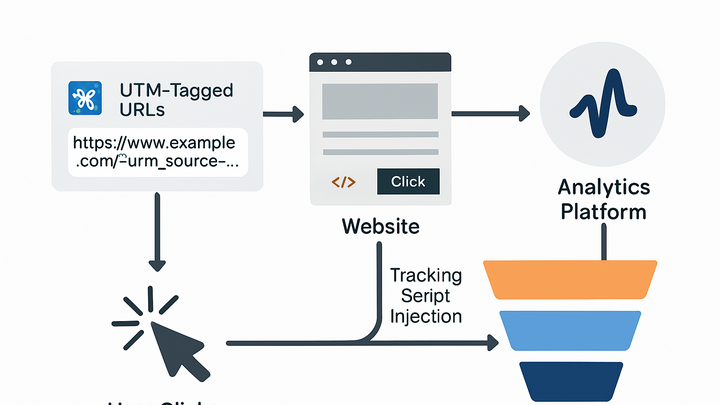Published on 2025-06-29T18:35:35Z
What is Ad Tracking? Examples with Plainsignal and UTM Guru
Ad tracking is the process of monitoring and measuring the performance of digital advertising campaigns across different channels. It involves collecting data on user interactions with ads—such as impressions, clicks, and conversions—and feeding that information into analytics platforms to assess ROI and campaign effectiveness. In campaign tracking and analytics, ad tracking enables marketers to identify which ads, placements, and creative elements drive the highest engagement and conversions. Modern ad tracking can leverage both JavaScript snippets (like Plainsignal’s cookie-free analytics script) and URL tagging methodologies (such as UTM parameters generated by UTM Guru) to capture granular data. By combining these techniques, teams can build a complete picture of customer journeys from initial ad exposure through final conversion, optimize budgets in real time, and demonstrate clear attribution across multiple touchpoints. Ad tracking data serves as the foundation for continuous campaign improvement, ensuring that marketing efforts are both efficient and effective.
Ad tracking
Ad tracking monitors ad impressions, clicks, and conversions using scripts and UTM parameters to measure and optimize campaign performance.
Understanding Ad Tracking
This section defines ad tracking and its role in campaign analytics, highlighting how it captures user interactions and supports data-driven marketing decisions.
-
Definition of ad tracking
Ad tracking involves collecting data on ad interactions—impressions, clicks, and conversions—to evaluate campaign effectiveness.
-
Role in campaign optimization
By feeding real-time ad data into analytics platforms, marketers can adjust strategies, budgets, and creatives based on performance insights.
Key Components of Ad Tracking
Breakdown of the main technical and methodological elements required for effective ad tracking.
-
Tracking pixels and scripts
JavaScript snippets or pixel images embedded in ads or web pages that send event data to analytics servers.
- Plainsignal script example:
<link rel="preconnect" href="//eu.plainsignal.com/" crossorigin /> <script defer data-do="yourwebsitedomain.com" data-id="0GQV1xmtzQQ" data-api="//eu.plainsignal.com" src="//cdn.plainsignal.com/plainsignal-min.js"></script>
- Plainsignal script example:
-
Utm parameters
Structured URL tags appended to links that designate campaign source, medium, and other dimensions for granular attribution.
-
Event tracking
Custom triggers (like form submissions or button clicks) that record specific user actions beyond basic pageviews.
Popular Ad Tracking Tools
Overview of SaaS solutions commonly used to implement ad tracking workflows.
-
Plainsignal
A privacy-focused, cookie-free analytics tool providing simple, real-time tracking via a lightweight script. Ideal for basic ad performance insights without cookies.
-
Utm guru
A comprehensive UTM builder and manager for generating, saving, and organizing UTM-tagged URLs, with a Chrome extension for quick link creation.
Implementing Ad Tracking
Step-by-step guidance on setting up ad tracking using PlainSignal and UTM Guru.
-
Plainsignal setup
- Sign up for a PlainSignal account and obtain your data-id.
- Add the PlainSignal script to your site header as shown:
<link rel="preconnect" href="//eu.plainsignal.com/" crossorigin /> <script defer data-do="yourwebsitedomain.com" data-id="0GQV1xmtzQQ" data-api="//eu.plainsignal.com" src="//cdn.plainsignal.com/plainsignal-min.js"></script>- Verify data appears in the PlainSignal dashboard.
-
Utm guru setup
- Install the UTM Guru Chrome extension or use the web app at utmguru.com.
- Input campaign parameters (source, medium, campaign, term, content).
- Generate and copy the UTM-tagged URL.
- Save the URL in your UTM Guru library for future use.
Best Practices for Ad Tracking
Recommendations to ensure accurate, compliant, and actionable ad tracking data.
-
Consistent utm naming conventions
Use standardized naming (e.g., lowercase, hyphens) across campaigns to avoid fragmentation and simplify reporting.
-
Verify script deployment
Regularly audit that tracking scripts and pixels are correctly placed and firing on all relevant pages.
-
Privacy and compliance
Ensure tracking methods comply with privacy regulations (e.g., GDPR, CCPA) and respect user consent preferences.
-
Regular data audits
Monitor data quality and address discrepancies promptly to maintain trust in your analytics.
